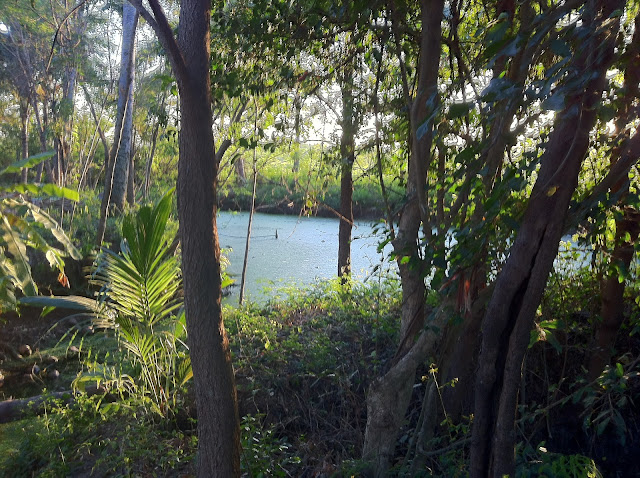After looking at this village in Google Earth I decided that it might be the site of an ancient Mon village. The Mon people, Buddhists from southern Burma, moved across central Thailand and into Isaan (northeast Thailand) in about the 7th century. They were later displaced by the Khmer who came up out of what is present day Cambodia.
The Mon had the habit of surrounding their settlements, from villages to cities, with roughly circular moats. This may have evolved from placing settlements in the sharp bend of a river and then cutting a canal to complete a loop. I have read that there are well over a thousand round-moated Mon villages in northeast Thailand.
Here's what Kham Thale Soh looks like from above. The image is from Google Earth.
The red line shows where I think remains of the old moat are. (The red arrow shows the location of an old rice mill in the village. More on that later.)
I decided to cycle out to the village to see if I could tell whether or not what looks like the remains of a moat really are the remains of a moat.
One of the roads leading to the village runs along this irrigation canal. The canal is lined with sugar palm trees. Many rural roads in Thailand got their start as access roads along the sides of canals. Over the years they get improved and eventually become thoroughfares.
Here an irrigation canal is being enlarged and the side roads improved.
I've always wondered why the main road through Kham Thale Soh is paved this way. I've never see a small village with this sort of road paving.
This road runs along the outer edge of the village. The old moat is off to the right. In most places it has been filled in or partially filled in and used for agriculture.
In some places bits of the moat remain as ponds for water storage.
Here's a cleaner bit.
Here's where the moat takes a bend to avoid the wat (temple) and then abruptly ends. This is on the Western edge of the village.
Here the remains of the moat are being used for a taro patch. This is on the southeastern edge of the village where the road enters.
I did manage to speak to an old woman (well, a few years older than I) who knew of the moat. She also said that the village is ancient (โบราณ in Thai).
Rice is the lifeblood of rural Thailand. Here a rice harvesting machine is being worked on after breaking down.
Here an "Etan" truck delivers rice to the grounds of a wat for drying. These trucks are hand made in Thailand and a very simple vehicles, often with no windshield. The engines are usually Kubota farm engines that can be removed and put to work pumping water or generating electricity.
A woman spreads the unmilled rice out to dry.

Most rice in Thailand is milled in big, modern factories. Kham Thale Soh has its own rice mill. That's it, above.
The machinery is fantastic. Mostly wood with belts and pulleys all over the place. Looks like a factory left over from the Victorian era.

The rice starts at the top and gets rolled and shaken over and over again.
Here's where the white, milled rice comes out. It seems to be a very slow process.
Here's a video I made of the machine in action. It was incredibly noisy and just a little bit scary.
This proud miller keeps the machinery running.
Milled rice goes into these bags.
So nice to end the day with another beautiful Isaan sunset.
Below is a link to click to see the location of Kham Thale Soh Village in Google Maps.

















No comments:
Post a Comment